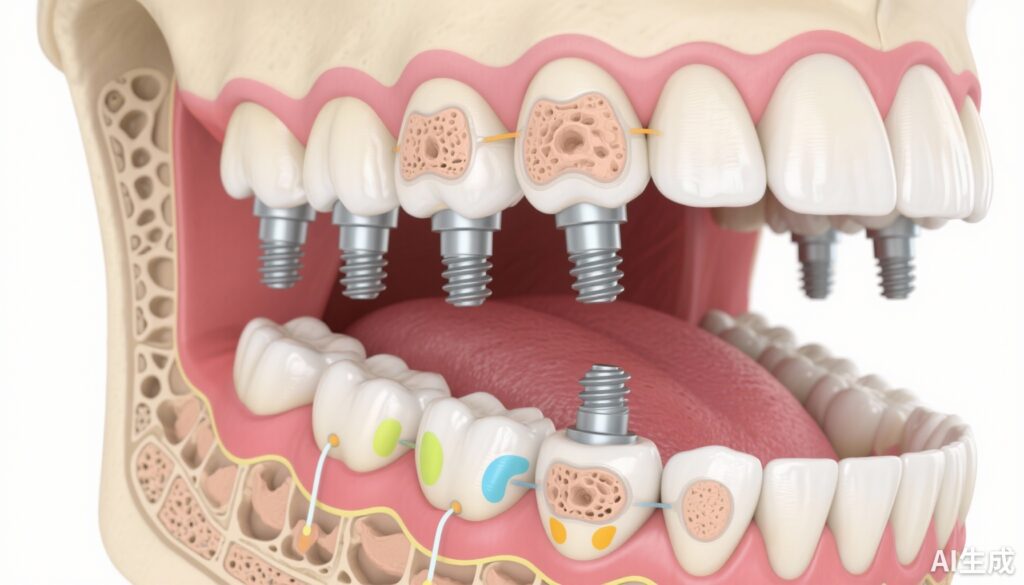Highlight
– The 7-year cumulative implant survival rate for fixed full-arch rehabilitation using All-on-4® implants was 91.9%.
– Bone grafting emerged as an independent risk factor for implant failure prior to definitive prosthesis placement.
– After definitive restoration, fewer implants, opposing natural teeth or fixed prostheses, and absence of night guard significantly increased implant failure risk.
– A nomogram integrating six predictors demonstrated moderate accuracy (AUC = 0.787) for predicting implant failure across treatment stages.
Study Background
Edentulism significantly affects patient quality of life, impacting mastication, esthetics, and psychosocial well-being. Implant-supported fixed full-arch rehabilitation, particularly with the All-on-4® concept, provides a predictable and cost-effective approach for restoring function and esthetics in edentulous maxillae and mandibles. Despite high reported success rates, implant failure remains a concern, potentially influenced by patient factors, surgical procedures, implant number, and prosthetic variables. Identifying stage-specific risk factors before and after definitive restoration is crucial to optimizing clinical outcomes and guiding personalized treatment strategies.
Study Design
This retrospective observational study included 141 edentulous or near-edentulous patients treated between January 2018 and April 2024 with All-on-4® (five or six implants) fixed full-arch rehabilitation and immediate loading across maxillary and mandibular arches. A total of 840 implants were placed, 377 in maxillae and 463 in mandibles. Key variables recorded encompassed patient demographics, surgical details including bone grafting, implant number, prosthesis type, opposing dentition, and night guard use.
For statistical analysis, LASSO regression was initially performed to select potential predictors. Subsequently, univariate and multivariate Cox proportional hazards frailty models examined risk factors for implant failures before and after definitive restoration independently. A stepwise logistic regression model constructed a nomogram predicting implant failure throughout the entire treatment course.
Key Findings
The observed 7-year implant failure rate was 4.52%, with a cumulative survival rate of 91.9% (95% CI: 88.4% to 95.6%). Implant failures were temporally stratified into 21 failures occurring before definitive restoration and 17 after restoration.
Before definitive restoration, bone grafting at the implant site independently increased failure risk. This likely reflects the complexities and biological challenges associated with graft integration and osseointegration in augmented bone.
After definitive restoration, three factors were independently associated with implant failure:
- Fewer Implants: Using fewer implants (five rather than six) raised failure risk, suggesting biomechanical overload or inadequate support may compromise longevity.
- Opposing Dentition: Implants opposed by natural teeth or fixed prostheses rather than complete dentures experienced higher failure rates, possibly due to increased occlusal forces and wear patterns.
- Absence of Night Guard: Patients not using night guards showed elevated failure risk, indicating that protection from parafunctional habits such as bruxism is important to safeguard implant integrity post-restoration.
The developed nomogram integrated six significant predictors across stages, demonstrating reasonable predictive accuracy (AUC = 0.787), providing a useful clinical tool for assessing implant failure risk and tailoring management.
Expert Commentary
This study reinforces the multifactorial etiology of implant failure in full-arch rehabilitations and underscores the importance of stage-specific risk stratification. The finding that bone grafting predisposes to early implant loss aligns with biological plausibility as graft sites demand meticulous surgical technique and longer healing times to ensure successful osseointegration. Clinicians should carefully evaluate graft quality and consider delaying restoration when appropriate.
The influence of fewer implants on failure risk after restoration corroborates existing biomechanical principles advocating for optimal implant distribution and number to withstand masticatory loads. Moreover, the impact of opposing dentition highlights that natural teeth exert greater occlusal stress on restorations compared to denture-bearing implants, thus necessitating more robust design and occlusal adjustment protocols.
Notably, the protective role of night guards emphasizes the need to assess and manage parafunctional habits proactively, which may otherwise precipitate mechanical complications or implant overload. This aligns with current prosthodontic guidelines recommending protective devices post-restoration, especially in high-risk individuals.
Limitations of this study include its retrospective nature and potential confounders such as patient systemic health, smoking, or precise bruxism assessment, which were not detailed. Nevertheless, the sizeable patient cohort and extended follow-up enhance validity.
Conclusion
The findings from this 7-year retrospective analysis affirm that fixed full-arch rehabilitation with four to six implants is predictably successful, with overall high survival rates. Implant failure risk varies by treatment stage, with bone grafting constituting a critical factor before definitive restoration, and fewer implants, opposing dentition, and lack of night guard use influencing failures thereafter.
Clinicians should comprehensively assess these risk factors throughout the treatment course to optimize implant survival. Decision-making may benefit from utilizing predictive nomograms and stage-specific management strategies, including careful planning of implant number, occlusion management, and consistent use of protective devices.
Future prospective studies incorporating broader patient variables and standardized protocols are warranted to further refine risk stratification and enhance personalized care approaches in full-arch implant dentistry.
Funding and Clinicaltrials.gov
No funding sources or Clinicaltrials.gov registrations were reported for this retrospective study.
References
Chen Y, Pu R, Xia Z, Yu K, Wang Y, Jiang Z, Yang G. Risk factors for implant failure of implant-supported fixed full-arch rehabilitation in edentulous maxillae and mandibles: A 1- to 7-year retrospective study. J Dent. 2025 Oct 3;163:106146. doi: 10.1016/j.jdent.2025.106146. Epub ahead of print. PMID: 41047093.



